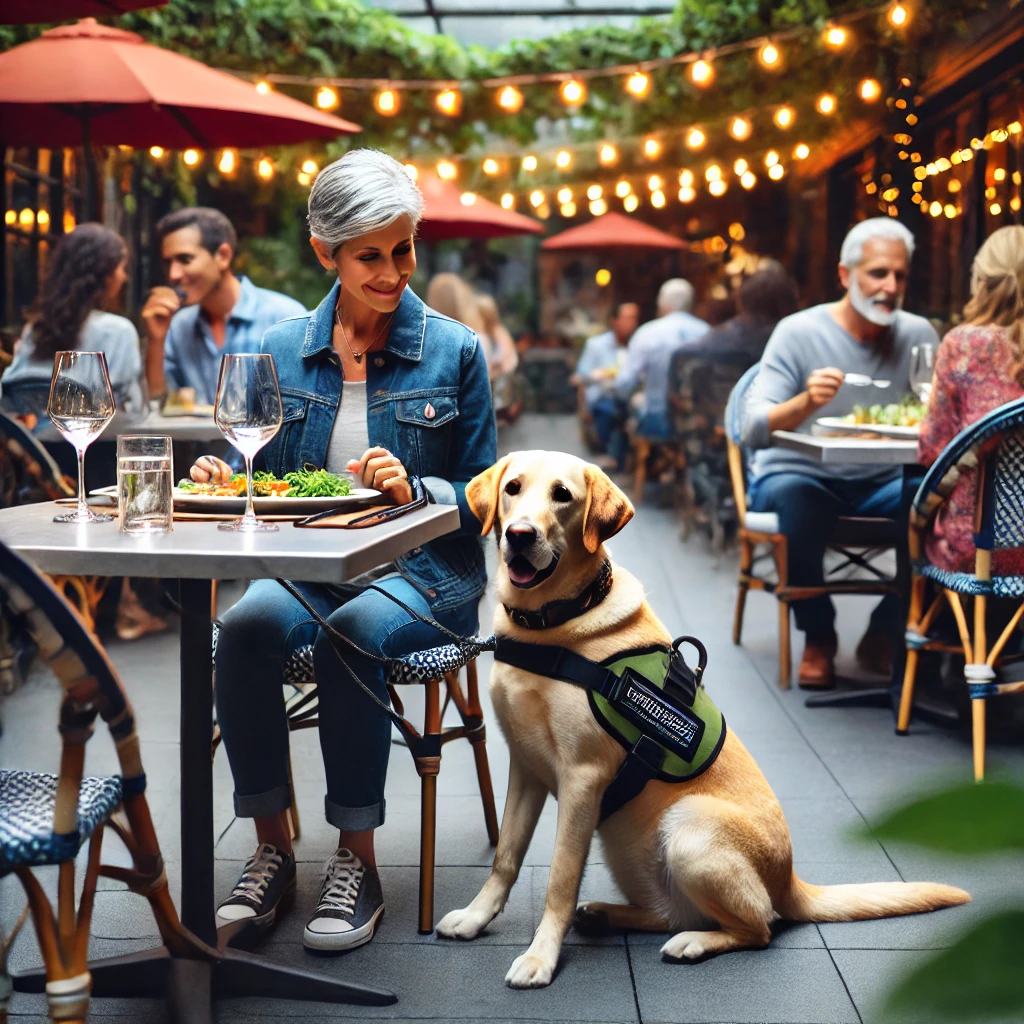Living with an emotional support animal (ESA) or a psychiatric service dog (PSD) brings incredible benefits, but it also often comes with the need to educate and communicate with others. Because ESAs and PSDs have different legal standings and functions, how you discuss them will vary. Whether it’s a landlord, an airline agent, a store employee, or just a curious passerby, clear and concise communication can help foster understanding, respect, and compliance with your rights.
Understanding the Key Differences First
Before you can effectively talk to others, you must clearly understand the distinctions yourself. This is the foundation of your communication.
-
Psychiatric Service Dog (PSD):
-
Definition: A PSD is a type of service animal specifically trained to perform tasks that mitigate a psychiatric disability. Examples include deep pressure therapy, retrieving medication, interrupting self-harm, or guiding in dissociative states.
-
Legal Protections: Covered by the Americans with Disabilities Act (ADA), granting public access rights (e.g., stores, restaurants, hospitals) and the Air Carrier Access Act (ACAA) for air travel. Also covered by the Fair Housing Act (FHA) for housing.
-
Training: Individually trained to perform specific tasks.
-
-
Emotional Support Animal (ESA):
-
Definition: An ESA provides comfort and emotional support through its presence, alleviating symptoms of a mental or emotional disability. They are not trained to perform specific tasks.
-
Legal Protections: Primarily covered by the Fair Housing Act (FHA) for housing accommodations. Not covered by the ADA for public access (most businesses) or the ACAA for air travel (as of January 2021).
-
Training: No specialized training required beyond being well-behaved.
-
Knowing these differences empowers you to communicate accurately and avoid misrepresenting your animal, which can lead to legal issues or public backlash.
Talking to Housing Providers (Landlords, Property Managers)
This is where both ESAs and PSDs have strong legal protections under the Fair Housing Act.
-
Be Proactive and Professional: Initiate the conversation in writing, ideally before you move in or as soon as you get your animal.
-
State Your Request Clearly: “I am requesting a reasonable accommodation under the Fair Housing Act to live with my emotional support animal/psychiatric service dog, [Animal’s Name/Type], due to my disability.”
-
Provide Your ESA/PSD Letter: This is your primary documentation. Present a legitimate letter from your Licensed Mental Health Professional (LMHP) on their official letterhead, clearly stating your disability and the disability-related need for the animal.
-
Explain “Reasonable Accommodation”: Politely inform them that, under the FHA, they are generally required to waive “no-pet” policies and associated fees for assistance animals.
-
Address Concerns Calmly: If they express concerns about breed restrictions, size, or type of animal, explain that such restrictions do not apply to assistance animals unless the animal poses a direct threat or causes undue burden, which must be based on individualized assessment, not generalizations.
-
Emphasize Good Behavior: Reassure them that your animal is well-behaved, house-trained, and will not cause damage or be a nuisance.
-
Refer to HUD Guidance (if necessary): If they are resistant or misinformed, you can politely refer them to HUD’s official guidance on assistance animals in housing.
Talking to Airline Personnel
The rules here are specific to Psychiatric Service Dogs (PSDs) under the ACAA. ESAs are generally treated as pets.
-
For PSDs:
-
Notify the Airline in Advance: You are typically required to submit a U.S. DOT Service Animal Air Transportation Form to the airline 48 hours before your flight.
-
State Clearly: “This is my psychiatric service dog, [Animal’s Name], and they are trained to perform tasks to assist me with my disability.”
-
Be Prepared to Answer Questions: Airline personnel can ask two questions: 1) Is this a service animal required because of a disability? and 2) What work or task has the animal been trained to perform?
-
Describe Tasks (Not Diagnosis): Be ready to briefly and clearly describe the specific tasks your PSD performs (e.g., “They provide deep pressure therapy to interrupt panic attacks,” “They retrieve medication,” “They alert me to overwhelming sensory input”). Do NOT disclose your diagnosis.
-
Carry DOT Form: Have your completed U.S. DOT Service Animal Air Transportation Form readily available.
-
Confirm Training: Reassure them that your PSD is highly trained and well-behaved.
-
-
For ESAs (if flying as a pet):
-
Be Honest: “This is my pet, and they will be traveling in a carrier under the seat/in cargo.”
-
Follow Pet Policies: Adhere strictly to the airline’s pet policies regarding carrier size, fees, and vaccinations. Do not try to misrepresent an ESA as a PSD, as this can lead to denied boarding or fines.
-
Talking to Business Owners/Staff (Public Access – ADA)
This primarily applies to Psychiatric Service Dogs (PSDs). ESAs generally do not have public access rights.
-
For PSDs:
-
Remain Calm and Confident: If questioned, answer clearly and concisely.
-
State Clearly: “This is my service dog.” (You don’t need to specify “psychiatric” unless you choose to, but it helps clarify their role for task-based questions).
-
Be Prepared for Two ADA Questions: Business staff can ask: 1) Is the animal required because of a disability? and 2) What work or task has the animal been trained to perform?
-
Describe Tasks (Not Diagnosis): Briefly explain the tasks your PSD performs. Focus on the action (e.g., “They interrupt self-harm,” “They retrieve dropped items when I’m disoriented,” “They provide a buffer in crowds”). Do NOT share your medical history.
-
Avoid Demonstrations: You are not required to demonstrate your dog’s tasks.
-
Address Behavior (if needed): If your dog is misbehaving, address it immediately. Service animals can be asked to leave if they are out of control or not house-trained.
-
-
For ESAs:
-
Respect “No Pet” Policies: Unless the establishment is explicitly pet-friendly, assume your ESA is not allowed. Do not attempt to assert ADA public access rights for an ESA, as they are not covered.
-
If Permitted: If a business is pet-friendly or voluntarily allows your ESA, ensure your animal adheres to excellent public etiquette (leashed, quiet, under control).
-
Talking to General Public (Curious Passersby)
This often involves educating and setting boundaries.
-
Be Prepared for Questions: People are naturally curious about animals, especially those with vests.
-
Decide Your Comfort Level: You are never required to disclose your disability or your animal’s specific role. You can choose to be brief or more informative.
-
Simple Explanations:
-
For a PSD: “They are a service dog.” or “They help me with a medical condition.” If asked to explain tasks: “They perform specific tasks that help with my disability.”
-
For an ESA: “They are my emotional support animal.” or “They provide me with comfort.” (Remember to clarify that they do not have public access rights like service dogs if the conversation goes there).
-
-
Set Boundaries: If someone attempts to distract, pet, or interact with your working PSD, politely but firmly say, “Please don’t pet them, they are working,” or “They are a service dog, and they need to focus.” For an ESA, you can simply say, “Please ask before petting.”
-
Educational Opportunity: You can use these interactions to educate others about the roles of assistance animals, but always prioritize your and your animal’s well-being. If someone is aggressive or disrespectful, it’s best to disengage.
General Communication Tips
-
Stay Calm and Confident: Your demeanor can significantly impact how others react.
-
Be Concise: Have a few clear, brief sentences ready for common questions.
-
Do Not Disclose Diagnosis: You are not legally required to share your medical diagnosis with anyone, only that you have a disability and a disability-related need for the animal.
-
Carry Relevant Documentation: Always have your legitimate ESA/PSD letter and any airline forms readily accessible.
-
Know Your Rights (and Limitations): Being well-informed about the FHA, ADA, and ACAA will empower you to communicate effectively and advocate for yourself and your animal.
Conclusion
Effectively communicating about your ESA or PSD is an ongoing process of education, advocacy, and sometimes, setting boundaries. By understanding the specific legal rights and distinctions of your animal, preparing clear and concise explanations, and maintaining a professional demeanor, you can navigate interactions with confidence. This not only ensures your access to necessary accommodations but also contributes positively to public understanding and acceptance of all assistance animals.
References
Americans with Disabilities Act of 1990, 42 U.S.C. § 12101 et seq. (2008).
Fair Housing Act, 42 U.S.C. § 3601 et seq. (1968).
U.S. Department of Housing and Urban Development. (n.d.). Assessing a Person’s Request to Have an Animal as a Reasonable Accommodation Under the Fair Housing Act. Retrieved from https://www.hud.gov/program_offices/fair_housing_equal_opp/assistance_animals
U.S. Department of Justice, Civil Rights Division. (2015, July 20). ADA Requirements: Service Animals. Retrieved from https://www.ada.gov/service_animals_2010.htm
U.S. Department of Transportation. (2020). Final Rule on Traveling with Service Animals. Retrieved from https://www.transportation.gov/briefing-room/us-department-transportation-announces-final-rule-traveling-service-animals





